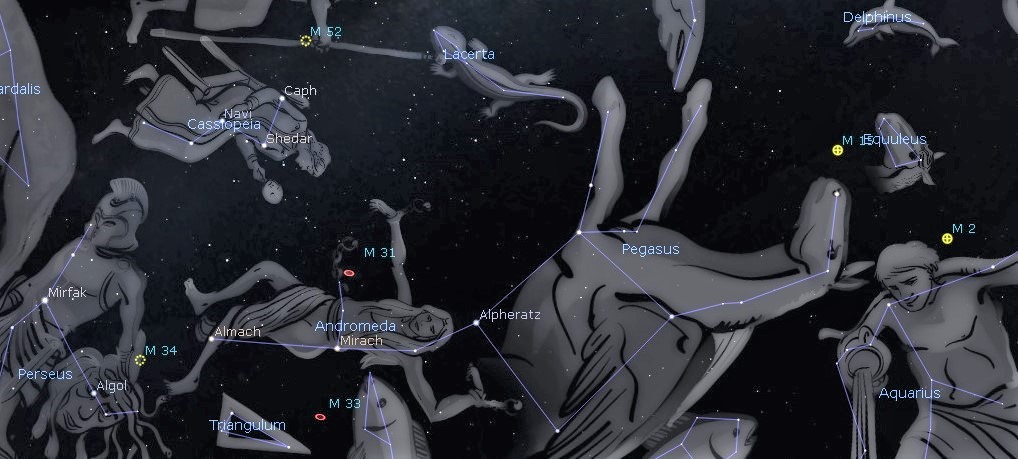This Week’s Sky at a Glance, 2020 October 31 – November 7
~by Curt Nason
Deep sky objects are often called faint fuzzies by amateur astronomers, but many are bright enough to be seen with binoculars. Let us start by using the Square of Pegasus as a guidepost. The southwest corner of the square is the base of the winged horse’s neck, and moving away from the square by a couple of stars takes us to the horse’s eye. Extending that line by the distance from the middle of the neck to the eye is where you will find a small blurry patch called M2, a globular cluster that is the second entry in the Messier list of deep sky objects. Angling to the left at the eye we come to a star at the horse’s snout, and extending by nearly half that distance is a larger globular cluster, M15.
The star at the northeast corner of the square is Alpheratz, the brightest star of Andromeda, from which spread two lines of stars. The second star away from Alpheratz along the brighter string is orange Mirach, and moving up two stars across the dimmer string we encounter the large Andromeda Galaxy, M31. From a dark sky you might notice a fat star and a subtle hazy patch close by. They are M32 and M110, satellite galaxies of M31, which might require large binoculars to separate them from M31. In the opposite direction from Mirach, and at about the same distance as M31, is fainter M33, the third largest galaxy in our Local Group behind Andromeda and the Milky Way. We see M33 face on, which makes it appear dimmer.
The third brightest star of Andromeda is Almach, situated at the end of the string from Mirach. Look in the area halfway between Almach and Algol, the second brightest star in Perseus, for the open cluster of stars called M34. Next, look above Andromeda for the familiar W-shape of Cassiopeia. A line from the bottom right star of the W to the top right and extended the same distance brings us to open cluster M52.
This Week in the Solar System
Saturday’s sunrise in Moncton is at 7:59 am and sunset will occur at 6:05 pm, giving 10 hours, 6 minutes of daylight (8:02 am and 6:12 pm in Saint John). With clocks reverting to Standard Time at 2 am this Sunday, next Saturday the Sun will rise at 7:09 am and set at 4:55 pm, giving 9 hours, 46 minutes of daylight (7:12 am and 5:03 pm in Saint John).
The most distant full Moon of the year occurs this Saturday, adding to the ambiance of Halloween. Mars is fading slowly and getting smaller as Earth pulls ahead, but it will remain large enough to show features in a backyard telescope through the next two months. Jupiter and Saturn make a lovely couple in the same field of view of most binoculars and they are setting around 9:30 pm. Mercury is in its best morning apparition for the year, rising 90 minutes before sunrise midweek and shining 15 degrees to the lower left of Venus.
With astronomy meetings and outreach activities on hold, you can watch the local Sunday Night Astronomy Show at 8 pm and view archived shows.
Questions? Contact Curt Nason.

